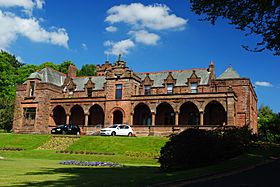Bearsden and Milngavie facts for kids
| Bearsden and Milngavie | |
 Boclair, Bearsden: Council's headquarters |
|
| Scot1975BearMiln.png | |
| Geography | |
| HQ | Bearsden |
| History | |
| Created | 16 May 1975 |
| Abolished | 31 March 1996 |
| Succeeded by | East Dunbartonshire |
Quick facts for kids Politics |
|
|---|---|
| Governance | Bearsden and Milngavie District Council |
Bearsden and Milngavie (Scottish Gaelic: Cille Phàdraig Ùr agus Muileann Dhaibhidh) was a special area in Scotland that had its own local government. It was one of 19 "districts" in the Strathclyde region. This area was located just north of the big city of Glasgow. It existed from 1975 to 1996.
Contents
History of the District
How Bearsden and Milngavie Started
The Bearsden and Milngavie district was created in 1975. This happened because of a new law called the Local Government (Scotland) Act 1973. This law changed how local areas in Scotland were managed. It set up a two-part system: larger "regions" and smaller "districts" within them.
Bearsden and Milngavie became one of these 19 districts inside the Strathclyde region. It took over parts of older areas that were no longer used. These older areas were:
- Bearsden Burgh (a type of town)
- Milngavie Burgh
- Part of Old Kilpatrick District, specifically the rural area of New Kilpatrick parish.
When the District Ended
The Bearsden and Milngavie district stopped existing in 1996. This was due to another new law, the Local Government etc. (Scotland) Act 1994. This law changed the system again. Instead of regions and districts, it created "unitary council areas." This means each area now had just one main council.
The land that was Bearsden and Milngavie district joined with most of the nearby Strathkelvin district. Together, they formed a new, larger area called East Dunbartonshire.
Who Was in Charge?
Political Control of the Council
The very first election for the Bearsden and Milngavie District Council happened in 1974. At first, this new council worked alongside the old councils. Then, on May 16, 1975, it officially took over. Here's how different political groups were in charge over the years:
| Party in control | Years | |
|---|---|---|
| No overall control | 1975–1977 | |
| Conservative | 1977–1992 | |
| No overall control | 1992–1996 | |
- No overall control: This means no single political party had more than half of the seats on the council. Different parties had to work together.
- Scottish Conservatives: This political party was in charge for most of the district's history.
Council Elections
People voted for their local council members in elections held every few years. Here's a look at how many seats each main party won:
| Year | Seats | Conservative | Liberal Democrats | Labour | Independent / Other | Notes |
|---|---|---|---|---|---|---|
| 1974 | 10 | 5 | 0 | 1 | 4 | |
| 1977 | 10 | 6 | 0 | 1 | 3 | |
| 1980 | 10 | 6 | 0 | 2 | 2 | |
| 1984 | 10 | 6 | 2 | 1 | 1 | |
| 1988 | 10 | 6 | 2 | 1 | 1 | |
| 1992 | 10 | 5 | 4 | 1 | 0 | |
Where the Council Worked
The main office for the Bearsden and Milngavie District Council was at Boclair. This building is located at 100 Milngavie Road in Bearsden. It was built a long time ago, between 1890 and 1891, and was first used as a care home.
In 1960, the old Bearsden Town Council bought the building. They turned it into their headquarters. Princess Margaret, a member of the Royal Family, officially opened it on May 31, 1962.
When the Bearsden and Milngavie District Council was created in 1975, they took over Boclair. It remained their main office until the district was abolished in 1996. After that, the new East Dunbartonshire Council used Boclair for extra office space. However, their main headquarters were in Kirkintilloch.
Eventually, East Dunbartonshire Council sold Boclair. The building has since been changed into a hotel.
See also

